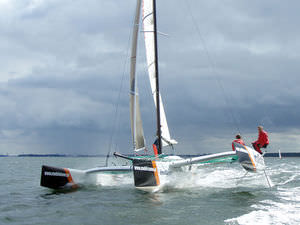
- Sailing
- Dinghy sailing
- Coastal racing sport catamaran
- eXploder Cats

- Products
- Catalogs
- News & Trends
- Exhibitions
Coastal racing sport catamaran EXPLODER 20double-handeddouble-trapezeFormula 20
Add to favorites
Compare this product
Characteristics
- Use
- coastal racing
- Crew
- double-handed
- Trapeze
- double-trapeze
- Sport multihull class
- Formula 20
- Other characteristics
- asymmetric spinnaker
- Length
6.1 m
(20'00" )
Description
The idea to create an uncompromising construction of a 20-feet catamaran arose during the Amber Cup in 2004. The initiation of this idea was Wojciech Kaliski, who engaged for this project Ryszard Partycki, a designer and contestants: Jack Noetzl, Adam Skomski and Jakub Kopyłowicz. The aim was to construct a catamaran which could effectively compete with Formula 18 in the Texel Rating classification. It was planned to used the best available materials and technologies in order to obtain a peerless construction.
In general, the foredesign boiled down to obtaining maximally fast boat at the rating slightly worse (TR=94-97) from F18 catamarans (TR=101), at least in certain conditions. In order to achieve this, catamaran’s width was increased to 3.26m, which was maximal due to road transport issues (permanently laminated spars). It resulted in obtaining a very high righting moment (for a heavy crew it amounts even to 1000 kGm, while for F18 it’s only 706 kGm). A higher righting moment enables higher aerodynamic forces on sails during a strong wind (at sailing against the wind from 16-18 knots of the apparent wind, i.e. from about 9 knots of the true wind. Hulls, especially the overwater part on the bow, were projected considering sailing on waves, in such way to limit longitudinal pitching and to decrease speed losses and possibilities of a keel over when a bow goes under a wave.
*Prices are pre-tax. They exclude delivery charges and customs duties and do not include additional charges for installation or activation options. Prices are indicative only and may vary by country, with changes to the cost of raw materials and exchange rates.




